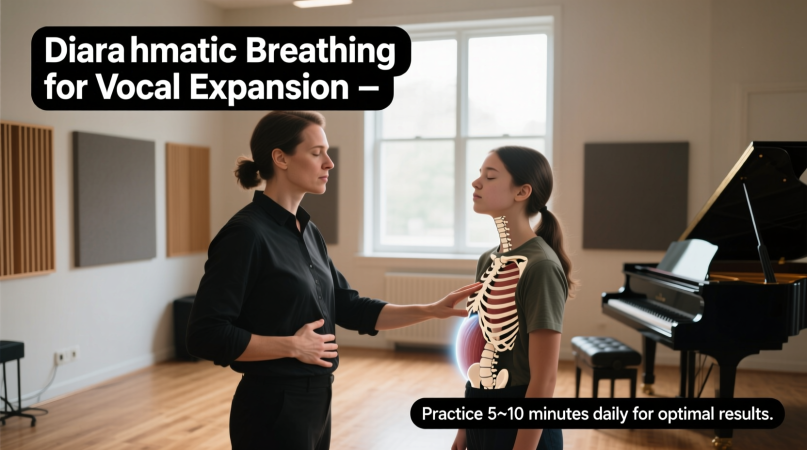
Most singers want to expand their vocal range—to reach higher notes with ease and strengthen their lower tones. What many overlook is that range is not only about vocal cords, but about breath control. The way you inhale, manage airflow, and release sound determines how far and how safely your voice can go.
Here are proven breathing techniques for singers that help unlock more notes and give your voice stamina.
Why Breathing Matters for Range
- Power: Airflow supports both strong low notes and resonant highs.
- Flexibility: Breath management makes transitions smoother across registers.
- Endurance: Good technique reduces fatigue, letting you practice longer.
👉 Without steady breathing, even singers with natural range will strain.
1. Diaphragmatic Breathing (Belly Breathing)
This is the foundation for every singer. Instead of shallow chest breaths, use your diaphragm.
How to practice:
- Stand or lie down with one hand on your stomach.
- Inhale slowly, letting your belly expand—not your shoulders.
- Exhale on an “sss” sound, keeping airflow steady.
Benefit: Gives you the control to sustain long phrases and hit higher notes without pushing.
2. Controlled Exhalation (The “Hiss” Drill)
To increase range, you need consistent airflow—not bursts.
How to practice:
- Take a deep diaphragmatic breath.
- Exhale slowly on a hiss (“sss”).
- Time yourself and try to extend the length each day.
Benefit: Builds stamina and prevents forcing air on high notes.
3. Breath Pulses for Strength
Range also depends on power when you need it.
How to practice:
- Inhale deeply.
- Exhale on “sss” in short, pulsed bursts (like beats).
- Start with 4 pulses, then 8, then 16.
Benefit: Strengthens your diaphragm and supports dynamic singing.
4. Straw or SOVT Breathing
SOVT (semi-occluded vocal tract) exercises reduce pressure on the vocal folds.
How to practice:
- Place a straw in a glass of water.
- Hum through the straw, making steady bubbles.
- Glide from low to high notes.
Benefit: Improves airflow and coordination, making high notes easier and low notes fuller.
5. Silent Quick Breaths
Great for fast songs and recovery between phrases.
How to practice:
- Open your mouth and inhale quickly, expanding your ribs.
- Keep it silent—no noisy gasps.
Benefit: Helps you recover between lines without breaking tone.
6. The Book on Belly Exercise
How to practice:
- Lie flat with a light book on your stomach.
- Inhale so the book rises.
- Exhale slowly so the book lowers steadily.
Benefit: Trains you to use the diaphragm automatically, even when standing.
7. Long Phrase Challenge
How to practice:
- Choose a simple song line.
- Try to sing it in one breath.
- Gradually increase phrase length as you improve.
Benefit: Expands endurance and range by managing breath across longer lines.
Sample 7-Day Breathing Plan
| Day | Focus Area | Exercise |
|---|---|---|
| 1 | Basics | Diaphragmatic breathing |
| 2 | Endurance | Controlled “sss” holds |
| 3 | Strength | Breath pulses |
| 4 | Coordination | Straw/SOVT bubbles |
| 5 | Recovery | Silent quick breaths |
| 6 | Awareness | Book on belly drill |
| 7 | Application | Long phrase singing challenge |
👉 Track your progress with the Vocal Range Calculator to see how breathing helps expand your notes over time.
FAQs
Does breathing really improve vocal range?
Yes. Breath control lets you sing higher and lower notes safely, without strain.
How long should I practice breathing each day?
10–15 minutes daily is enough for most singers.
Which breathing exercise is best for high notes?
Straw (SOVT) breathing and diaphragmatic support help most with upper range.
Can posture affect breathing for singing?
Absolutely. Stand tall, keep your ribs open, and avoid slouching to allow full breath.
